Fortress of 'Poggio Imperiale' (Poggibonsi)
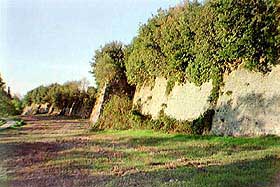 |
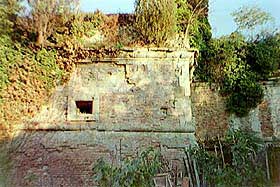 |
| The external bastioned curtain of walls that surround the hill for one km. | The bastions of the fortress. |
The fortress of the Poggio Imperiale dominates the town of Poggibonsi and is easily reachable from the center following the indications.
Click here to see an aerial photo and a plan of the fortress
The Medicean Fortress called of the 'Poggio Imperiale', built between 1488 and 1511 by the great architect Giuliano da Sangallo, on charge of Lorenzo the Magnificent, at dominion of the Cassia road toward Siena, was one of the first test for the realization of the new conceptions of fortification that were developing in that years. Its importance in the history of the military architecture is great. No other urban enterprise undertaken in the 15th century in central Italy has the characteristics of majesty of this: on the 'Poggio Imperiale' Lorenzo didn't want to raise only a great fortress but he wanted to start the foundation of a new city. The work was incomplete, either for Lorenzo's death in 1492 and for the evolution of the conflict between Siena and Florence with the consequent end of the strategic importance of the hill, and the fortress has come to our days in its embryonic state. For this reason is for us easier to read its structure, thanks to the lack of following architectural contamination.
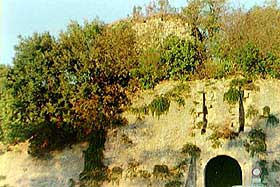 |
| The entry of the external walls curtain. |
The work is formed by two structures tightly tied up among them: the walled enclosure of the hill and the fortress itself. On the western side of the hill lies the incomplete bastioned walls, erected for about half of its programmed extension. These doesn't follow a particular geometric line but were modeled on the ground orografy and are developed for around a kilometer.
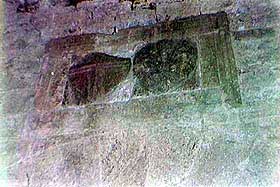 |
The coats of arms in stone in the hall of the entry of the external walls curtain |
The years of abandonment and carelessness have created a situation in which today the work is almost totally amalgamated with the surrounding nature, but still in a good state of maintenance, to retries of the solidity and of the care set in its construction. The walls were realized primarily in bricks with the exception of the angles and the gun holes for which was used the stone. The inner space of the walls is endowed of a 'gallery of listening' against the hostile mines. On the most western side we find the only gate, built entirely in stone and gifted in origin of a drawbridge from which hall, adorned of two coats of arms in stone of the Florentine Republic, the aforesaid gallery can be accessed. On the left of the gate rises a stone tower, the only rest of the preexisting settlement of the hill, enclosed in the new defensive system. This settlement, called 'Poggiobonizio', is returning to the light, thanks to archaeological excavations. Crossed the gate a road in beaten earth conducts to the peak of the relief, where fortress rises.
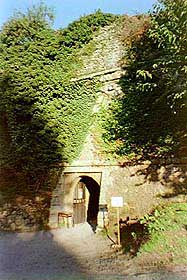 |
| The gate of the fortress at the center of the western side. |
The fortress is on a plain place and thanks to this was possible to give a geometric rectangular form to its plan with a point, like a barbican, set to the center of the oriental external side. This particularity let the plant of the construction look like a pentagon. On each of the angles a bastion is found, two on the western back side toward the city and three (two plus the point) on the opposite side. To one of the two western bastions are connected the hill bastioned walls. Also the access to the fortress is practiced on this side. A long gallery conduct us to the inner area, through a construction of four plans, called keep but anymore a barracks built on the north-south axle, and long so much to reach the two great sides of the fortress and gifted of a chapel.
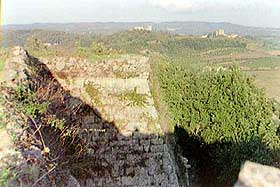 |
| The extreme point of the oriental side, all in travertine stone. |
The fortifications of the fortress are most curate in comparison to those of the external walls, but also they are built in bricks with the gun holes and the angles strengthened in travertine stone. Only the external point was realized entirely in stone for all its height. On all the bastioned walls of Poggio Imperiale are practiced gun holes. Up to few years ago the inner ward of the fortress was turned into cultivation, recently were begun works of recovery of the space with the restoration of the 'keep', today often turned as seat of expositions. It would be opportune to recover to green also the rest of the inside area, from which is enjoyed a magnificent view on the outskirts.
The fortress of 'Poggio Imperiale', for the age in which was built, can be considered the forerunner of 'bastioned-city' that we will in large part find in the fortified architecture of the following centuries.
| View a Map |
| Back to Homepage |
| Back to Castles Index |

